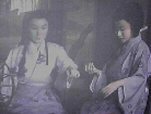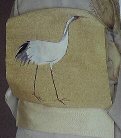I would like to take this time and tell you a little history about the traditional kimono. Before I start I think, you should know what the word kimono means. It simply means "clothing", but it is referred to as the traditional one-piece wrap-around robe worn by both men and women.
The kimono dates back well over 1000 years and has taken on many transformations since that time, both in stylistically, and in the way it is made.It is the traditional clothing for the Japanese and Okinawan people.
Back in the Edo era (1615 - 1868) the Shogun's ladies wore colorful ones. Back in that time the kimono was a ceremonial robe called Uchikake. The uchikake consisted in seven layers each one is different in color and design but very well match up, to bring out the stunning effects of the uchikake. The uchikake is different than the traditional kimonos that are worn more offend to day as we know it. Now the uchikake is a wedding kimono. The white kimono is the traditional wedding kimono called, "shiromuku" it means, "white and pure."
The brides are both beautiful and stunning in red and in white, as done in the Shinto weddings.
The obi is the sash tied around the center of the kimono. It can be tied in a variety of ways, from the simple to the most elaborate ways. The obi can be as wide as one foot and as long as 13 feet. Being married to a beautiful Okinawan bride, you can take my word, that some of the complicated styles may take as long as half an hour to tie.
As the kimono evolved in to outerwear the potential for more creative, as well as expressive design, kimonos became beautiful works of art. Particularly striking, are the kimonos of the Edo period, which have pictorial designs, dyed into the silk fabrics, resembling the colorful effects of the wood-block prints. There was a time that well known artists was commissioned to paint their surfaces. Superb embroidery that utilized gold and silver thread, embellished the kimonos not to say the least.
Now day's young people only wear the kimono only for special events or special occasions. The special occasions include weddings, New Years and formal parties. The reason the kimono is not or more often, even though they are so beautiful is because, the kimono is not as easy to move around in, as compared with the western styled clothes and the time consumed in putting it on.
I am sorry to say that only a few people can put on a kimono to day by themselves. Some people go to kimono dressing school to learn how to put a kimono on. There are the others that don't have the time or the money to go to the school so, they seek out the ones that know how to put on and wear the kimono to assist them in put on the kimono for special occasions. There are many types of kimonos to fit all the times, places and occasions. The kimono is generally bright and elaborate and has been said, to make a woman appear more beautiful.
Last updated 06/12/06




During the period of (795-1185) the kimonos must have been magnificent and it's appearance should have been stunning to say the least. Two of the first worlds novelist, Lady Murasaki Shikibu, (938-1031) in her novel titled "The Tale of Genji" and Lady Murasali Shikibu, (1000-1015) "The Pillow-book of Sei Shonagon" translated by Arthur Waley (1925-1933) described the kimonos in their writing as, multi layered costumes made of the finest silk with up to a dozen or more layers of contrasting colored kimonos would be worn!

